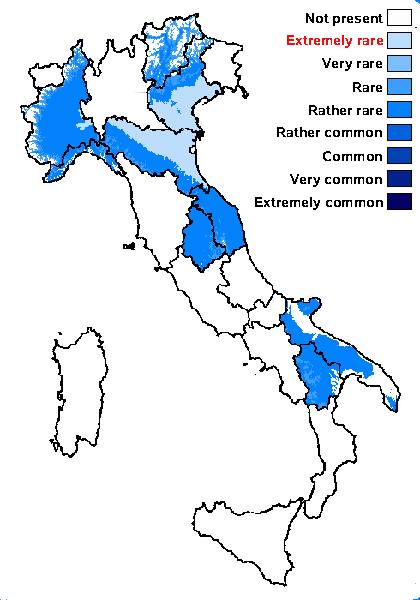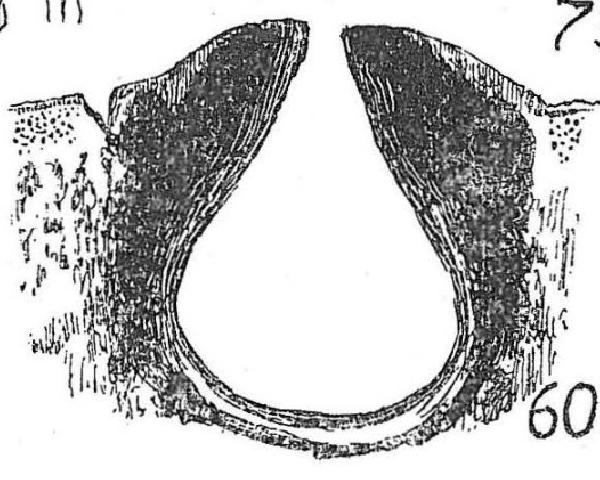Verrucaria weddellii Servít
Stud. Bot. Cech., 7: 80, 1946.
Synonyms: Verrucaria transiliens auct. non (Arnold) Lettau
Distribution: N - Ven (TSB 10446), TAA (Nascimbene 2005), Piem, Emil (Nimis & al. 1996, Fariselli & al. 2020), Lig. C - Marc (Nimis & Tretiach 1999), Umb (Genovesi & al. 2002, Ravera & al. 2006). S - Pugl (Nimis & Tretiach 1999), Bas (Nimis & Tretiach 1999).
Description: Thallus crustose, episubstratic, rimose-areolate, brown, smooth to slightly rough, 0.2-0.4 mm thick, the areoles angular, flat to slightly convex, 0.3-0.6 mm wide, incompletely subdivided by cracks. Cortex 10-20 µm thick, overlain by a thin epinecral layer; algal layer 50-100 µm thick; medulla subparaplectenchymatous, with a colourless upper part and brownish lower zone with substrate particles and crystals, without a black basal layer. Perithecia black, 1-3 per areole, remaining immersed in raised portions of the areoles and almost completely covered with a thalline layer, only the very tips naked. Involucrellum extending almost to base-level, laterally 40-80 µm thick, slightly thinning toward the base, arching slightly away from exciple, the space inbetween pale and packed with crystals; exciple subglobose, 0.3-0.4 mm across, the wall 20-25 µm thick, brown to brown-black; hamathecium of branched-anastomosing periphyses and periphysoids measuring 35-50 x 2.5-4 µm, interascal filaments absent; hymenial gel hemiamyloid, I+ red (I+ blue at very low concentrations of I), K/I+ blue. Asci 8-spored, clavate, I-, fissitunicate, the wall thickened above, with an ocular chamber, dehiscent by extrusion of an endotunica to form a delicate rostrum, Verrucaria-type. Ascospores 1-celled, hyaline, ellipsoid or oblong-ovoid, 20-25 x 9-12 µm. Photobiont chlorococcoid. Spot tests: K-, C-, KC-, P-, UV-. Chemistry: without lichen substances.
Note: this species was almost always confused with V. transiliens by Italian authors; I have placed here all records by Italian authors of V. transiliens except those by Sbarbaro, whose material was probably identified by Servít. The species grows on porous calciferous rocks with temporary seepage of water after rain, in rather sheltered situations. For further details see Breuss (2004) and Roux & coll. (2014: 1265).
Growth form: Crustose
Substrata: rocks
Photobiont: green algae other than Trentepohlia
Reproductive strategy: mainly sexual
Poorly known taxon in need of further study
Commonnes-rarity: (info)
Alpine belt: absent
Subalpine belt: absent
Oromediterranean belt: absent
Montane belt: rare
Submediterranean belt: rather rare
Padanian area: extremely rare
Humid submediterranean belt: rather rare
Humid mediterranean belt: absent
Dry mediterranean belt: absent

Predictive model
Growth form: Crustose
Substrata: rocks
Photobiont: green algae other than Trentepohlia
Reproductive strategy: mainly sexual
Poorly known taxon in need of further study
Commonnes-rarity: (info)
Alpine belt: absent
Subalpine belt: absent
Oromediterranean belt: absent
Montane belt: rare
Submediterranean belt: rather rare
Padanian area: extremely rare
Humid submediterranean belt: rather rare
Humid mediterranean belt: absent
Dry mediterranean belt: absent

Predictive model
 INDEX FUNGORUM
INDEX FUNGORUM
 GBIF
GBIF
 DOLICHENS
DOLICHENS


